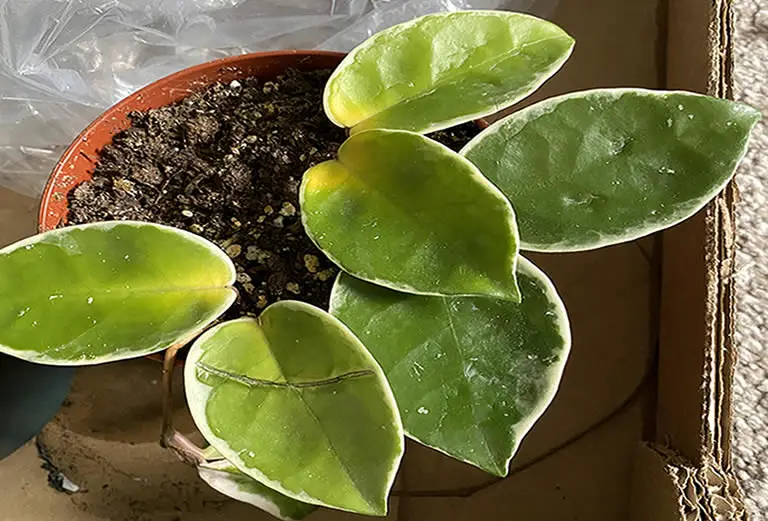The hoya is a flowering succulent genus plant with up to 300 species that is mostly grown in the US as a houseplant. These dogbane family members are known for their waxy, star-shaped flowers. If yellowing has ruined the visage of your hoya, you’ll want to get to the bottom of it right away so you can take action and fix your ailing plant. Here we will look at the causes for hoya leaves turning yellow and their solutions.
Table of Contents
- Why are my hoya leaves turning yellow?
- 1. Underwatering can cause hoya leaves to turn yellow
- 2. Overwatering can cause hoya leaves to turn yellow
- 3. The wrong water type can cause yellowing in hoya
- 4. Strong direct sunlight can cause hoya leaves to turn yellow
- 5. Excess fertilizer use can cause hoya leaves to turn yellow
- 6. Nutrient deficiencies can cause hoya leaves to turn yellow
- 7. Incorrect temperature can cause hoya leaves to turn yellow
- 8. Pests can cause hoya leaves to turn yellow
- Final word – why your hoya leaves are turning yellow & how to fix them
Why are my hoya leaves turning yellow?
The hoya plant is a genus of tropical succulent that grows natively in the Indomalayan realm and that consists of over 300 species of Apocynaceae.
All apocynaceae plants have been traditional considered dogbane (plants that kill or are repulsive to dogs).
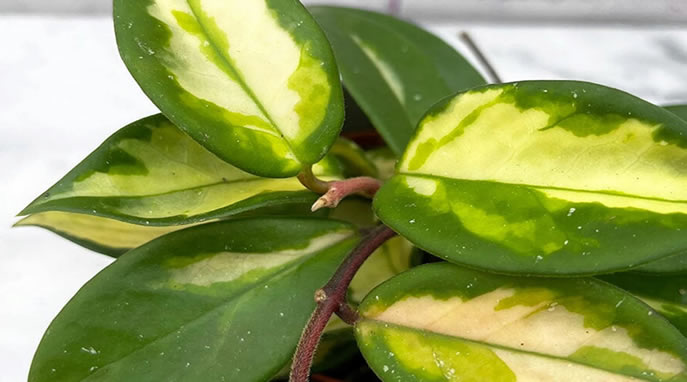 However, hoya houseplants are completely safe for both dogs and cats regardless of their traditional reputations. See this handy toxic and non toxic plant list.
However, hoya houseplants are completely safe for both dogs and cats regardless of their traditional reputations. See this handy toxic and non toxic plant list.
8 causes + their solutions:
Being a tropical plant the hoya requires specific care though as long as you follow the correct guidelines this is an easy-care plant that requires very little attention.
When you hoya starts displaying yellow or yellowing leaves this is an indication that your care routine is wrong and the plant has a problem.
A hoya can exhibit yellow leaves due to one or more of the following 8 causes:
- Underwatering.
- Overwatering.
- Using the wrong type of water.
- Too much direct sunlight.
- Excessive fertilizer.
- Nutrient deficiencies.
- Incorrect temperature.
- Pests.
This guide to hoya foliage discoloration, specifically as this relates to a yellowing of the leaves, will examine the above causes in detail.
I advise you to quickly review each section even if the cause seems glaringly obvious to you after reviewing the list above.
Sometimes there can be more than one reason for hoya leaves turning yellow!
By acquainting yourself with each of the above mentioned cause you will be able to easily diagnose exactly what is going on with your specific houseplant.
In this article I will not only outline the causes for yellowing hoya leaves, I will also discuss the cures, with actional solutions, for each of the aforementioned causes.
This way you can quickly and easily take immediate steps to restore the greenery to your hoya leaves.
1. Underwatering can cause hoya leaves to turn yellow
Being a succulent a hoya requires much less water than most other houseplants.
It is therefore a very common occurrence, at least in my experience, to find that hoya houseplants are consistently being overwatered.
Succulents are naturally drought-resistant plants. The hoya is no exception.
Hoya flowers are not only known for the beauty, they are also known for their waxy texture. But, the hoya’s flowers aren’t the only part of this plant with a waxy texture.
The leaves also possess that same waxy sheen which is clearly visible on indoor plants. Part of that has to do with the hoya’s drought resistant nature.
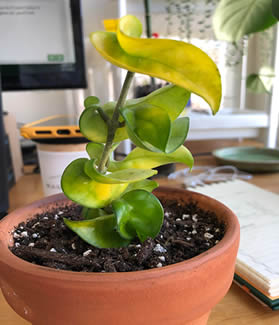
A drought-resistant plant, such as the hoya, can go longer without being watered than your average houseplant.
When it is given more water than it needs the plant will react negatively (which I will cover in the next section).
However, obviously drought-resistant plants need water too.
Watering too infrequently or offering too little water will cause your hoya’s leaves to turn yellow.
Outside of the foliage discoloration, you might also witness symptoms such as dried leaf tips with brown spots, dry soil, and leaf and plant wilting.
How to treat yellowing hoya leaves due to underwatering
Begin establishing a regular watering schedule for the hoya, but be aware that the amount of water this plant needs will vary depending on the season and also the temperature of the local environment in which it is growing (your home).
During the warmer weather of the spring and summer, which is also the hoya’s active growing season, you can water the plant once weekly as long as the soil looks as though it has dried out i.e. the top layer of soil should be completely dry.
In the autumn and winter and the latter season especially, it’s suitable to wait two weeks before resuming watering.
As the plant is no longer in its growing season it will require less water.
However, be aware that if you have a form of central heating in your home the soil may dry out quicker than you anticipated.
Please do not stop watering your hoya at any point. I’ll talk about this more later, but the hoya does not go dormant.
It still needs water even when it’s not actively growing much.
I suggest that rather than relying on a set schedule for watering your hoya in the beginning, it is best to test the soil for moisture using your finger until you learn the the watering needs of your individual plant.
To do this simply stick your index finger into the soil to a depth of about 1 inch, or up to the first knuckle of your finger.
If your finger is completely clean when you remove it this indicates that your plant needs watered.
If there is dirt residue stuck to your finger when you remove it, then there is still adequate moisture in the soil and the plant does not require watering.
When you perform the finger test over several weeks you will soon learn the watering needs of your plant and be able to create a watering schedule around that.
Remember the top layer of soil to a level of about 1 inch should be dry before watering the plant again.
2. Overwatering can cause hoya leaves to turn yellow
Overwatering is one of the most common problems I encounter with succulent houseplants.
Some houseplant owners are unaware that the hoya is drought-resistant. Some have touched its leaves and because they felt crispy, they assumed the plant needed water.
Either way, I find that many hoya houseplant owners water their hoyas as much as every three days or even as much as every other day.
Such an aggressive watering schedule is far too much for this Asian houseplant to handle.
When it comes to any succulent it is always better to err of the side of caution. It is much better to take a lighter, more infrequent watering approach with succulents, the hoya included, than it is to douse the poor plant in water.
This is true of any drought-resistant plant.
When in doubt don’t water the plant until you have checked the moisture levels in the soil.
If the finger test is not accurate enough for you (or you don’t like getting your finger dirty), you can purchase a cheap moisture meter, many of which will also check the ph level of the soil and light exposure to your plant (very handy for light-sensitive succulents).
Hoyas, like all succulents, are especially susceptible to root rot, a disease that kills the roots of your houseplant one by one robbing your plant of water and nutrients. Because root rot starts, as you would imagine, in the rootball of the plant it can be difficult to spot before serious damage is done.
Since you can’t see into the soil, you rarely realize that root rot is happening until your plant begins looking sickly, sad, and discolored.
If the foliage is allowed to decay to should a point that the plant is losing leaves, root ball death has progressed to such a point that your plant may no longer be savable.
When it comes to root rot fast diagnose and fast action are the keys to saving the plant.
But how can you be sure that root rot is the problem and that there is not some other cause at work?
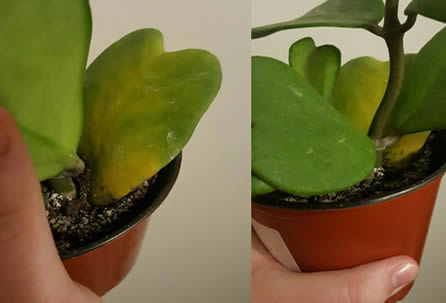
If your hoya plant has yellow dry leaves but the soil is clearly moist this is a strong indication of root rot.
Mushy leaf stems (clearly visible in the above image) are also a clear indication that the plant is suffering from root rot.
You can always remove the plant from its pot so that you can examine the roots.
How to treat yellowing hoya leaves due to overwatering
If you identify root rot (the infected roots will be either dry and brittle or they will be completely mushy), be sure to cut away all the dead roots before repotting the hoya in a new pot with fresh soil.
Root rot is extremely serious for any plant and even after taking the aforementioned steps it is not guaranteed your plant will survive though it is worth the effort to try to save it.
I can’t stress enough the importance of following a correct watering schedule.
Be sure to consider the season and temperature when determining the next time to water your hoya.
Always check the moisture levels in the soil using one of the aforementioned techniques before watering your hoya in future as this way you will avoid root rot occurring again.
How to water hoya to avoid leaf yellowing
Hoya leaves do not like to get wet. Also, wet hoya leaves can sunburn in strong sunlight turning them yellow.
To avoid getting water on the leaves of a hoya plant be sure to only water it from the bottom.
Allow the plant to sit in a few inches of water for about 10 minutes.
This way the roots will soak up exactly the amount of moisture the plant needs and no more.
3. The wrong water type can cause yellowing in hoya
Although the use of hard water is a much less common reason for hoya leaves turning yellow it is something that occurs occasionally.
So I have therefore included this information in this section as it may be something you experience with your plant.
Before considering hard water as a possible culprit for the yellowing of your hoya leaves though, be sure to investigate the other potential causes outlined in this article. It is more likely that one of those will be to the blame.
So what is hard water and how can it negatively affect your hoya plant?
When you water your plants, where does that source of water come from?
If your answer is your kitchen or bathroom sink, then that could be one reason why your hoya is sporting yellow leaves.
More than likely, the tap water coming from your faucet is hard water.
According to water filter retailer EcoPure, up to 85% of homes in the United States have hard water.
What exactly is hard water, you ask?
Hard water is water that contains dissolved magnesium and calcium.
Other minerals and salts might also be present in hard water, depending on where it is sourced.
Hard water does not look any different from soft water, which is free of the above minerals.
However, you can usually tell that you have hard water coming through your pipes if you know what to look for.
You might not always feel clean when bathing or washing your hands using hard water. It’s almost like there’s a film on your skin.
Your water pressure is not that great no matter what you do to fix it.
Most noticeably, you might see spots on glass surfaces, from your shower to your favorite glassware.
You may also see residue buildup in your kettle.
Hoyas don’t like hard water, as they’re sensitive to many minerals and salts, which is something we’ll discuss more in just a moment when it comes to the use of fertilizer.
Even if you water your hoya the correct way in the correct frequency, if the water is too hard, your hoya’s leaves can still become yellow.
The correct type of water to give a hoya plant to avoid the leaves turning yellow
If hard water is causing your hoya to produce yellow leaves then you must use mineral-free water for your hoya moving forward.
As a solution you can simply collect rainwater for your plants or buy pure water.
However, I recommend you either add a water filter to your home’s faucets or use the cheaper option of a water filter pitcher for processing houseplant water.
4. Strong direct sunlight can cause hoya leaves to turn yellow
Hoya plants may be tropical succulents but leaving them for sustained periods of time in strong direct sunlight will cause a fading of foliage color.
But it can also additional problems to a yellowing of the leaves.
The yellowing color of burnt leaves on a hoya plant are often accompanied by a crisping effect where the leaf dries out and becomes brittle.
This effect can be made worse if you also water the plant from the top or mist it and thus get water onto the leaves.
All hoya plants prefer indirect light over direct light.
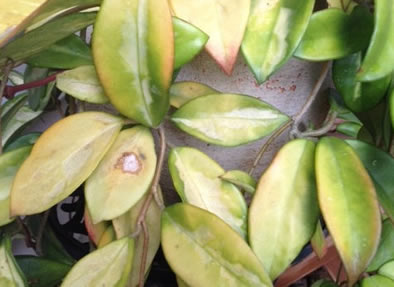
Although it is possible to give a hoya plant approximately 2 hours of direct light per day, no more than that is advisable.
However, the very fact that too much direct light will burn the leaves of the plant means that I much prefer to avoid direct light altogether when it comes to the placing of this succulent.
Nature, and the sun, don’t always like to stick to your schedule. It is all too easy to forget about your plant and leave it baking in the hot sun all day thus leading to leaf burn.
So, be sure to just give the plant good indirect light and you will avoid the risks of leaf burn entirely!
How to treat yellowing hoya leaves due to sun damage
Place your hoya houseplant in a location that gets plenty of strong indirect sunlight.
Avoid placing the plant in an area that gets direct sunlight unless you are absolutely sure the plant will get nor more than 2 hours of direct light per day.
If you cannot find a place in your home that gets good indirect sunlight do not be tempted to put you plant in a sun-facing window ledge if that area gets strong sun for long periods.
Instead use a small grow light to help make up for any light deficiency.
This way you will protect the plant’s foliage from becoming bleached in the sun.
You will know your plant is not getting enough light if growth is slow and/or the foliage loses its lustre or displays fading color.
5. Excess fertilizer use can cause hoya leaves to turn yellow
Most houseplant fertilizers contain three macronutrients: phosphorus, nitrogen, and potassium.
Included with these there will also be micronutrients, which can be anything from molybdenum to manganese, zinc, iron, copper, and boron.
Fertilizing your houseplants is a must (except for a handful of species), but how much fertilizer you use, as well as how often you do it, is dependent on the plant species.
Most succulents require much less feeding than other common houseplants.
For plants like the hoya, that don’t like too many minerals or salts in their soil, you must tread a very fine line when it comes to fertilization.
Over-fertilizing an indoor hoya plant can cause symptoms such as reduced growth, root death, brown or yellow leaves, wilting, and white fertilizer crust on the soil’s surface.
Even just one instance of over-fertilizing the plant can cause your hoya duress, leading to a yellowing of the leaves, while repeat offenses might even lead to the plant’s death.
How to treat yellowing hoya leaves due to over-fertilization
The hoya plant grows from the spring to the autumn, and thus, requires fertilizer just during this half of the year only.
Indoor gardeners have been known to fertilize their hoyas in the winter, but I’d recommend you refrain from doing that to avoid a potential issue with over-fertilizing.
Although hoya do not go dormant, like many other houseplants do, they do not require feeding during the non-growth period.
6. Nutrient deficiencies can cause hoya leaves to turn yellow
You eat a well-rounded diet full of nutrients, minerals, and vitamins, right?
What you don’t get through your diet, you may even introduce through supplements, such is the importance of nutrients to the body.
Lack of macronutrients and micronutrients often leads to nutrient deficiencies.
Well, houseplants need a well-rounded diet as well or they too could develop nutrient deficiencies.
As mentioned, the three macronutrients that houseplants require are nitrogen, potassium, and phosphorus. Each of the three macronutrients serves different purposes.
For instance, nitrogen is for energy management, nutrient uptake, and water regulation.
Potassium encourages growth, as it can activate enzymes that manage a plant’s metabolism, affect the plant’s rate of protein synthesis, and trigger photosynthesis.
Phosphorus further encourages photosynthesis in houseplants.
Some plants require a balanced fertilizer with the same amount of nitrogen, phosphorus, and potassium.
Other plants, such as the hoya, need a different nutrient mix.
If you don’t get the ratio correct, then your hoya will develop problems including unsightly yellow foliage.
Without proper nutritional support hoya leaves may wilt, and plant growth can stop as well. If your plant doesn’t have the correct nutrients to support itself, this could lead to death without amelioration.
Liquid fertilizers with a high nitrogen count work best for hoya as the plant is primarily composed of foliage. However, about 2 months prior to blooming I use a phosphorus-heavy fertilizer to encourage blooms.
You can avoid the need for fertilizer altogether by simply repotting your hoya in the appropriate type of fresh soil.
How to treat yellowing hoya leaves due to nutrient deficiencies in the soil
Hoyas must have fertilizer with a higher ratio of nitrogen. Look for liquid fertilizers with a ratio of 3:1:2 (like this) or 2:1:2.
Just before your hoya begins producing its beautiful waxy flowers, then the houseplant requires more phosphorus than it does nitrogen.
The phosphorus will support blooming. You now want fertilizer with a ratio of 5:10:3 or a 5:10:5 (like this one).
The fertilizer is still high in nitrogen but has more phosphorus than the usual formula helping give the plant a blossom boost.
You can also consider adding a half-dose of liquid fertilizer in the winter to support a hoya that’s been under-fertilized or that is wrestling with nutrient deficiencies. Do this as long as you are very careful not to over-fertilize.
7. Incorrect temperature can cause hoya leaves to turn yellow
Have you checked your thermostat lately?
Many houseplants prefer room-temperature environments in the high 60s and mid-70s, and that’s also true of the hoya.
The lowest allowable temperature for this houseplant is 60° Fahrenheit and its highest preferable temps are 85° F.
The hoya can withstand cooler temperatures than even the low 60s, all the way to the low 40s, though I don’t recommend leaving the plant in such low temperatures for long periods.
Once the mercury in your thermostat drops below 40°, your hoya will begin exhibiting signs of cold stress.
One sign is chlorosis, which is a term for leaf yellowing.
In very low temperatures your hoya’s foliage will sag, the leaves will become narrow, and germination can slow or stop. Existing seedlings will experience stunted growth.
A hoya placed near a chilly window or outside access door that is opened can often be affected by outdoor temperatures. Cold stress is much more of a problem with hoya plants that are yard grown though or with potted hoya that are placed outdoors.
If you bring your hoya inside when it starts to display signs of cold stress, the houseplant shouldn’t have long-term health effects.
However, prolonged exposure to the cold could cause necrosis, which is cell death from the temperatures.
Although the hoya is a tropical plant that originates in warm regions of Asia it does not like temperatures hat go beyond 85°.
Heat stress can be just as detrimental as cold shock, causing leaf yellowing and curling, wilting, and even sun scalding.
How to treat yellowing hoya leaves due to temperature damage
Keeping a comfy room-temperature environment for the hoya shouldn’t be a struggle. Normal household temperatures are more than adequate for a hoya plant.
However I must mention that heat and cold sources that can cause problems for you plant don’t only come from your heating/cooling vents.
A drafty door, a window air conditioner, a radiator, and even your fridge/freezer can produce gusts that will stress out your plant.
So, consider the placement of a hoya houseplant carefully!
8. Pests can cause hoya leaves to turn yellow
Growing a plant is always going to lead to some creepy-crawlies at one point or another. Even houseplants are not free from pests. So growing hoya can lead to the same problems.
It’s okay to see a few critters here and there (such as caterpillars), but the problem comes when the bugs begin propagating on your houseplant and feeding on it aggressively.
The various hoya species attract their fair share of critters that are eager to suck up the plant’s sap and deplete its nutrients resources.
Spider mites, scale insects, mealybugs, and aphids are the common culprits for hoya plants.
Let’s take a closer look at these unwanted critters.
Spider mites
Spider mites include roughly 1,200 unique species of microscopic bugs.
If the mites gather in large enough numbers, you might be able to distinguish the webs they weave on your hoya’s leaves. These silk webs will be present on the underside of the leaves.
Although spider mites are small, when they infest your hoya, they can suck up the plant juices and leave your plant weak.
Your poor hoya is then more susceptible to diseases.
Also, when a hoya is infected with mites any instances of overwatering, underwatering, or over-fertilizing could be deadly.
Because the plant is in such a poor state of health and unable to deal with the pest added problem it could die. See our article how often should you water a hoya.
Scale insects
Determining that your hoya has a scale insect problem is far more difficult than dealing with spider mites, as scale insects can look like many different species.
Some have hard coats and others are soft-bodied.
All are a danger to your hoya however! Luckily most insecticides will eliminate the pests regardless of species.
Mealybugs
Mealybugs are the most common pest I have found on indoor hoya plants (though spider mites are a close second).
Conditions that are warm and moist attract mealybugs and infestations tend to follow.
The favorite plants for these bugs to feed on are tropical, subtropical trees, houseplants, and greenhouse plants.
That means your hoya is certainly susceptible to a mealybug invasion!
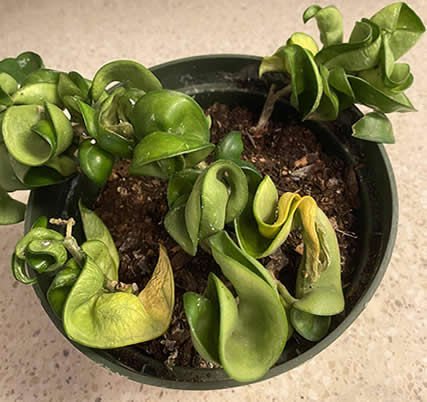
Mealybugs carry a one-two punch of danger. For one, they will ingest plant juices happily.
More so than that though, they’re known as disease spreaders.
The double pronged attack can make it very difficult for your hoya to recover from a mealybug infestation unless you treat it early at the first signs of trouble.
Aphids
Finally, there are aphids. Aphids cause havoc with hoya plants.
The colors of aphids run the gamut, which makes it even more confusing that these insects are known as blackflies or greenflies.
Aphids, like scale insects, do not have one uniform appearance either and this can make it difficult to identify them as the culprit.
Again, the good news is that most good insecticides will kill any type of bug infestation. So you don’t absolutely need to know exactly what species of bug is attacking your plant in order to get rid of them.
How to deal with pests on your hoya plant
If you prefer the organic approach then you can use neem oil, which is very effective for eliminating plant bugs.
Should your plant have a particularly bad infestation I would suggest you go for something stronger and opt for a chemical approach in the form of an insecticide.
I much prefer organic solutions but sometimes infestations are so bad that it is advisable to go with the quickest and most deadly option which is always chemical.
Good modern insecticides (like the one I linked to above) also help combat the diseases caused by some bugs (like mealybugs) as well as killing the bugs themselves.
If you identify the problem early enough and you would like to use a less harsh treatment, you can use rubbing alcohol or dish soap with water in a spray bottle along with a damp cloth.
Simply spray the foliage and gently wipe the leaves clean.
With the more natural treatments I advise you to continue applying your treatment for several days until you no more traces of bugs are evident.
With chemical treatments follow the guidance on the product label as overuse can be as detrimental to the plant as the bugs.
Final word – why your hoya leaves are turning yellow & how to fix them
In most cases when you spot several yellow leaves on your hoya, this is your plant’s way of telling you that you’re care routine has one mistake or several.
Sometimes yellowing leaves are caused by pest infestations.
It is important you identify the exact cause of the leaf yellowing which you can do by reviewing the 8 potential causes listed within this article.
First, you should amend your watering habits. Remember that it’s not only about the quantity of water you use, but its source. Avoid hard water for the hoya.
If fixing your watering frequency doesn’t help, then examine how often you’re fertilizing the plant and what kind of nutrient ratio the hoya’s receiving.
Be sure the plant is not getting too much direct sunlight as this will cause leaf burning and turn the foliage yellow.
Check your thermostat and avoid placing your plant in areas where there are drafts or sudden changes of temperature (such as close to a fridge or freezer).
Be sure to keep an eye out for insects as well.
When you read and review the guidelines in this article you will be able to quickly diagnose what’s wrong with your particular hoya. Then, along with the advice I have given, you will be able to get your plant on the road to recovery.

